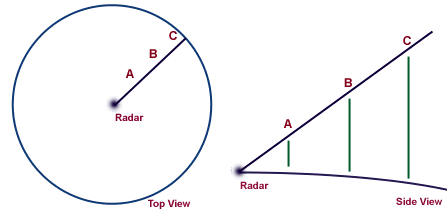|
|
. |
Interpreting Doppler Radar Velocities
speed shear wind patterns
To understand Doppler radial velocity
patterns, one first has to
consider the geometry of a radar scan. Normally the radar beam is pointed
at an elevation angle greater than
zero so that the beam, as it moves away
from the radar, moves higher and higher above the surface of the earth.
Because of this geometry, radar returns originating from targets near the
radar represent the low-level wind field, while returns from distant targets
represent the wind field at higher levels.

On a radar
PPI display, the distance away from the radar at the
center of the display represents both a change in horizontal distance and a
change in vertical distance. To determine the wind field at a particular
elevation above the radar, one must examine the radial velocities on a
ring at a fixed distance from the radar. The exact elevation represented
by a particular ring depends upon the elevation
angle of the radar beam.
In the examples below, idealized Doppler
radial velocity patterns were
constructed with a computer assuming simple vertical wind field patterns.
These simplified radial velocity patterns can help us understand the more
complicated patterns that are associated with storm motions.
Doppler velocity patterns (right) correspond to vertical wind profiles (left),
where the wind barbs indicate wind speed and
direction
from the ground up to 24,000 feet.
Negative Doppler velocities (blue-green) are toward the radar and
positive (yellow-red) are away.
The radar location
is at the center of the display.
[Image: wind direction constant with height (35K)]
Image by:
Brown & Wood
For this first example,
wind direction is constant with height,
but wind speed increases from
20 knots at the ground to 40 knots at 24,000 feet. Note on the
radial velocity
field that the maximum inbound velocity is to the west and maximum outbound
to the east while to the north and south the radar measures zero radial
velocity. This is because the winds are perpendicular to the radar beam when
viewed to the north or south.
[Image: maximum speed at mid levels (32K)]
Image by:
Brown & Wood
In the second example, the winds increase from 20 to 40 knots between
zero and 12,000 feet and then decrease again to 20 knots at 24,000 feet.
The wind direction again is constant.
The radar beam intersects the 12,000 foot level along a ring half-way across
the radar display. This is where we see the maximum inbound and outbound
velocities.
[Image: difluent wind flow (29K)]
Image by:
Brown & Wood
In the third example, we see a wind field which changes direction from
north to south but has a constant speed at all heights. The zero radial
velocity line now bends so that it is everywhere perpendicular to the wind
field. The maximum radial velocities
are observed where the radar beam
points directly toward or away from the wind direction.
[Image: confluent wind flow (30K)]
Image by:
Brown & Wood
In our fourth example, we see the same effect but in this case, the flow
is confluent instead of difluent.

Imagery
|
|

directional shear
|
|


